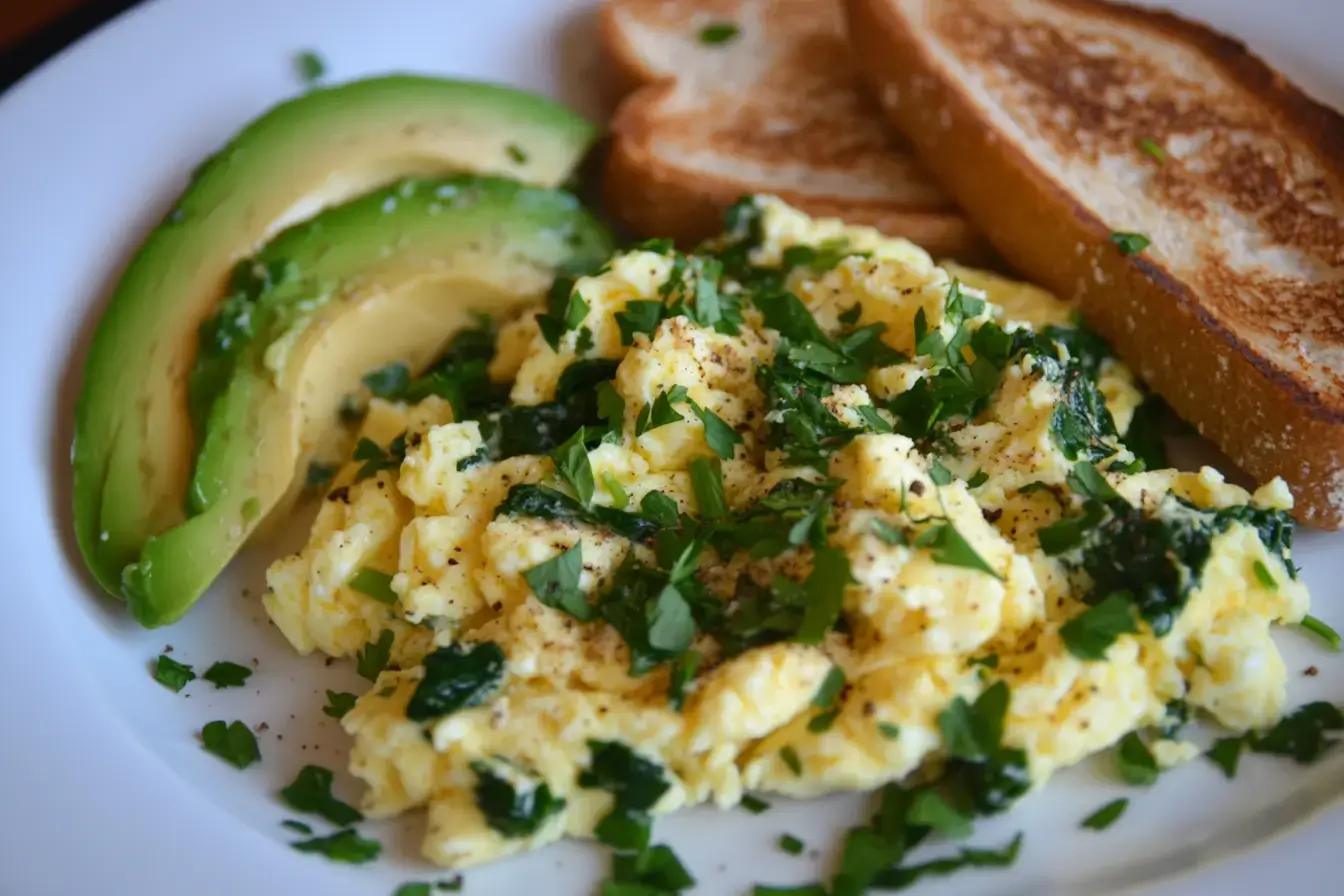Ah, scrambled eggs! They’re a breakfast classic that many of us cherish. But when you toss in some vibrant spinach, you elevate this simple dish into something truly special. Whether you’re a busy professional looking for a quick meal or a parent trying to sneak in some greens for your kids, scrambled eggs with spinach are a delicious and nutritious choice. In this guide, we’ll explore the nutritional benefits of scrambled eggs with spinach, tackle common cooking problems, and share tips to make your dish stand out. So, let’s crack some eggs and get started!
Nutritional Benefits of Spinach in Your Diet
Before we whisk those eggs, let’s discuss why spinach deserves a spot on your plate. This leafy green is a powerhouse of nutrients that can transform your breakfast into a health-boosting meal.
Vitamins and Minerals in Spinach
Spinach is loaded with vitamins and minerals. Here’s a quick breakdown:
| Nutrient | Amount per 100g |
|---|---|
| Vitamin A | 469 µg |
| Vitamin C | 28.1 mg |
| Vitamin K | 483 µg |
| Iron | 2.7 mg |
| Calcium | 99 mg |
Health Benefits of Eating Spinach
Eating spinach can offer a variety of health benefits:
- Boosts Immunity: The high vitamin C content helps strengthen your immune system.
- Supports Eye Health: Spinach contains lutein and zeaxanthin, which are great for your eyes.
- Bone Health: With its high vitamin K content, spinach is excellent for maintaining strong bones.
- Heart Health: Spinach is rich in antioxidants that can help reduce inflammation and lower blood pressure.
Why Choose Scrambled Eggs with Spinach?
Now that we know how awesome spinach is, let’s talk about why pairing it with eggs is a match made in culinary heaven.
A Quick and Easy Meal Option
Life can get hectic, right? Scrambled eggs with spinach are quick to prepare, taking about 10 minutes from start to finish. It’s the perfect solution for those busy mornings or when you need a fast meal without sacrificing nutrition.
“Can I use scrambled eggs with other vegetables?
Absolutely! Mix in bell peppers, tomatoes, or mushrooms for extra flavor and nutrition!”
Versatility in Breakfast and Beyond
Scrambled eggs with spinach aren’t just for breakfast! You can enjoy them at lunch or dinner, too. Add them to a wrap, serve them on toast, or mix them into a salad. The options are endless!
“What is the difference between scrambled eggs with spinach and frittata?
A frittata is baked and thicker, while scrambled eggs are cooked quickly on the stovetop for a fluffier texture!”
“Cooking is like love. It should be entered into with abandon or not at all.” – Julia Child

Common Problems When Making Scrambled Eggs with Spinach
Even though scrambled eggs with spinach sound easy, they can sometimes lead to common cooking mishaps. Let’s discuss some of these issues so you can avoid them!
Overcooking the Eggs
One of the biggest mistakes people make is overcooking eggs. This can lead to rubbery, dry eggs no one wants to eat. The key is to cook the eggs on low heat and remove them from the pan while still slightly undercooked. Otherwise, they will continue to cook off the heat.
Spinach Texture Issues
Have you ever had spinach that’s too soggy or chewy? It can ruin the whole dish. To avoid this, té the spinach just enough to wilt it without losing its vibrant color and texture.
Lack of Flavor
Nothing is worse than bland scrambled eggs! If you don’t season them properly, they can taste flat. A sprinkle of salt, pepper, and maybe a dash of your favorite hot sauce can make all the difference.
Solutions to Common Problems
Now that we’ve identified some common problems let’s explore solutions to ensure your scrambled eggs with spinach are nothing short of perfection!
Perfecting the Cooking Time
To achieve fluffy scrambled eggs, cook them on medium-low heat and stir gently. KMonitorthem and remove them from the heat when they’re still slightly runny. Trust me, they’ll firm up perfectly!
Preparing Spinach for Optimal Texture
To ensure your spinach has the right texture, wash it thoroughly and remove any tough stems. Sauté it in olive oil or butter until it’s wilted, which usually takes about 2-3 minutes.
Enhancing Flavor with Seasoning
Don’t be shy with seasoning! A pinch of salt, a dash of pepper, and perhaps some garlic powder or fresh herbs can elevate the flavor of your dish. Experiment with different spices to find your favorite combination.
Ingredients for Scrambled Eggs with Spinach
To prepare delicious scrambled eggs with spinach, gather the following ingredients:
| Ingredient | Quantity | Notes |
|---|---|---|
| Large eggs | 4 | Fresh and organic for the best flavor. |
| Fresh spinach | 1 cup | Washed and roughly chopped. |
| Milk | 2 tablespoons | Optional for creamier eggs. |
| Olive oil or butter | 1 tablespoon | For sautéing the spinach. |
| Salt and pepper | To taste | For seasoning. |
| Shredded cheese | 1/4 cup | Optional, such as feta, cheddar, or goat cheese. |
| Fresh herbs | To taste | Optional, such as chives or parsley, for garnish. |
Tips for Making the Perfect Scrambled Eggs with Spinach
Now that we’ve discussed some common problems and their solutions let’s explore some tips that will help you master the art of scrambled eggs with spinach!
Choosing the Right Eggs
The type of eggs you use can significantly impact the flavor and texture of your dish. Fresh, organic eggs are often richer in taste and color than conventional eggs. If you have access to farm-fresh eggs, definitely try them!
Selecting Fresh Spinach
When it comes to spinach, freshness is key. Look for bright green leaves without any yellowing or wilting. If you can, buy organic spinach to avoid pesticides and enjoy the best flavor. Remember, the fresher the ingredients, the better your dish will taste!
Cooking Techniques for Fluffy Scrambled Eggs
To achieve those fluffy, restaurant-style scrambled eggs, consider these techniques:
- Whisk Well: Before cooking, whisk your eggs thoroughly to incorporate air, which helps make them fluffy.
- Low and Slow: Cook your eggs on low heat. This allows them to cook evenly without becoming rubbery.
- Stir Gently: Use a spatula to stir the eggs gently as they cook. This creates soft curds and prevents overcooking.

Variations of Scrambled Eggs with Spinach
While the classic scrambled eggs with spinach are delicious, there are plenty of ways to mix things up! Here are some variations to consider:
Adding Cheese for Creaminess
Who doesn’t love cheese? A sprinkle of feta, cheddar, or goat cheese can add a creamy texture and flavor. For the best results, fold it in at the end of cooking!
Incorporating Other Vegetables
Feeling adventurous? Try adding other veggies! Bell peppers, tomatoes, or mushrooms can complement the spinach beautifully. Just sauté them along with the spinach for a colorful, nutrient-packed dish.
Pairing Suggestions for Your Dish
Now that you have your scrambled eggs with spinach let’s discuss what to serve them with. Pairing your dish can elevate your meal to a new level!
Best Side Dishes
Here are some tasty side dishes to consider:
- Whole Grain Toast: A slice of whole-grain toast is perfect for scooping those delicious eggs.
- Avocado Slices: Creamy avocado adds healthy fats and pairs wonderfully with eggs.
- Fruit Salad: A refreshing fruit salad can balance the savory flavors of your dish.
For an effortless breakfast, you can consider Avocado Toast with Egg: A Fiber-Packed Breakfast You’ll Love
Beverage Pairings
Don’t forget about beverages! Here are a few drink options that complement your meal:
- Fresh Orange Juice: The sweetness and acidity of orange juice can brighten your breakfast.
- Coffee or Tea: A warm coffee or herbal tea can round out your meal perfectly.

Conclusion: Elevate Your Breakfast Routine
Scrambled eggs with spinach are more than just a meal; they’re a way to start your day with energy and nutrients. You can transform this simple dish into a culinary masterpiece with the proper techniques and creativity. So, the next time you’re in the kitchen, remember these tips and tricks to make your scrambled eggs with spinach shine!
Frequently Asked Questions (FAQs)
Let’s address some common questions about scrambled eggs with spinach:
Can I Use Frozen Spinach?
Absolutely! Frozen spinach is a convenient option. Just thaw and drain it well before adding it to your eggs to avoid excess moisture. It can save you time and still provide great flavor and nutrition. Plus, it’s often picked at peak freshness so you won’t miss out on all those vitamins and minerals. Remember to sauté it briefly to revive its texture before mixing it with your eggs!
How Can I Make This Dish Vegan?
If you’re looking for a vegan version of eggs, try scrambled tofu instead. Season it with turmeric for color and nutritional yeast for a cheesy flavor. Toss in your spinach just like eggs for a delicious alternative! You can also add a splash of plant-based milk to make the tofu creamier. This way, you can enjoy a hearty breakfast without animal products while getting all those nutrients!
What’s the Best Way to Store Leftover Scrambled Eggs?
If you have leftover scrambled eggs, store them in an airtight container in the refrigerator. They can typically last about 3-4 days. To reheat, use a microwave or a skillet over low heat, adding a splash of milk to keep them moist. Just make sure to heat them gently to avoid drying them out. This way, you can enjoy a quick and easy breakfast without the hassle of cooking from scratch every time!
Can I Add Herbs to My Scrambled Eggs?
Yes, adding herbs to your scrambled eggs can elevate the flavor immensely! Fresh herbs like chives, parsley, or basil can bring a delightful freshness to the dish. Just chop them finely and mix them in right before serving to retain their vibrant color and flavor. Dried herbs like oregano or thyme can also work well if fresh herbs aren’t available. Experiment with different combinations to find your favorite herbal blend!
How Do I Know When My Scrambled Eggs Are Done?
Look for a soft, creamy texture to determine if your scrambled eggs are done. They should be slightly undercooked when you remove them from the heat, as they will continue to cook off the heat. Stir gently while cooking, and watch for them to form soft curds. If they look dry or rubbery, they’ve likely been overcooked. Aim for a light golden color, and remember that residual heat will finish the cooking process!




